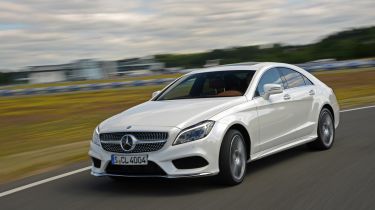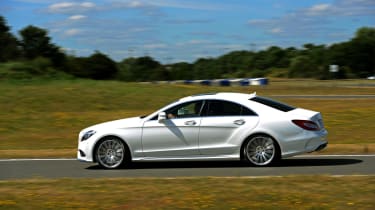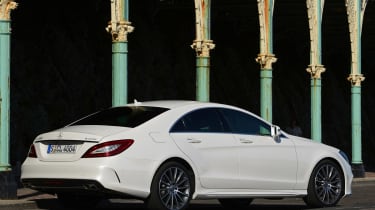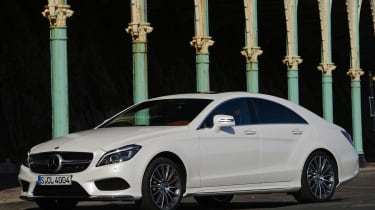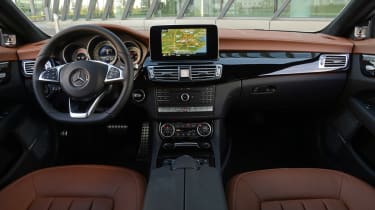Mercedes CLS (2011-2018) review
The sleek and stylish Mercedes CLS combines head-turning coupe looks with four-door practicality

The first-generation Mercedes-Benz CLS made its debut at the 2004 New York auto show, following a long period when there hadn’t been a ‘proper’ E-Class sized coupe.
The popular W124 version had been axed in 1995, and its follow-up was the CLK-Class – a C-Class saloon in drag, pretending to be a luxury model. It hung around for a while, but didn’t really convince buyers of the previous car.
A rethink was required, and the 2004 CLS was the result of Merc’s continued belief that the ‘classic’ two-door coupe format was too outmoded and too impractical to be a viable volume seller in the E-Class segment.
So the CLS was an immediately eye-catching new saloon with practicality playing second fiddle to sleek coupe-like styling, and it quickly forged a new niche for Mercedes. Copycat rivals like the Audi A7 Sportback and BMW 6 Series Gran Coupe piled-in later, but the CLS in its various guises can also be seen as a rival to models as varied as the Jaguar XFR and XJR, Maserati Ghibli, and the Porsche Panamera.
The first CLS was replaced in 2010 with the W218 model that shared the previous version’s sweeping profile and proportions, but brought an added dash of aggression with an SLS Gullwing-inspired front end and a beefier stance.
Used - available now

2022 Toyota
C-HR
44,007 milesAutomaticPetrol1.8L
Cash £17,300
2022 Nissan
Micra
22,169 milesManualPetrol1.0L
Cash £10,800
2025 Toyota
Yaris Hybrid
37,962 milesAutomaticPetrol1.5L
Cash £14,300
2023 Audi
A3 Saloon
52,952 milesManualPetrol1.5L
Cash £20,387The CLS saloon – or ‘CLS Coupe’ as Mercedes prefers to call it – was joined in 2012 by an estate version called the CLS Shooting Brake, which again places style ahead of practicality in its chosen sector.
The first AMG-powered example was the CLS 55 AMG with around 470bhp in 2004, swiftly followed by the 507bhp CLS 63 AMG in 2006. The latest generation – now boasting 577bhp and badged the Mercedes-AMG CLS 63 S – has helped cement the CLS as one of the Mercedes-Benz brand’s iconic performance flagships.
There are two petrol and two diesel engine options in the CLS line-up today, offering a decent range of performance options. The trim levels have been simplified too, with the two diesel models offered in base AMG S Line trim, the more powerful twin-turbo petrol version offered with slightly better equipment in the 400 AMG S Line trim, and the AMG 63 S as a stand alone model with all the bells and whistles.
When the original Mercedes CLS hit UK showrooms in 2005 it caused an instant stir. By mixing four-door versatility, sleek coupe styling and a luxurious cabin, the CLS was a true trendsetter. The Mk2 added sharper driving dynamics and efficient new diesel and petrol engines to its list of desirable attributes. All versions are well equipped, but that doesn’t mean you’ll be able – or want - to avoid the expensive options list.
The flagship Mercedes-AMG 63 S is a true performance icon, with a mighty 5.5-litre twin-turbo engine ensuring it has the firepower to match its looks.
Engines, performance and drive
Drivers wanting the ultimate in sporty driving dynamics should look elsewhere. However, the Mercedes CLS’s fine ride and handling set-up strikes the right balance between fun and comfort. Adaptive damping is standard on all models, which means the Mercedes copes effortlessly with poorly surfaced roads.
Yet the direct and well-weighted steering, good body control and decent grip make the Mercedes a surprisingly agile choice – in fact the nimble handling responses and cocooning roofline can give the impression you’re driving a smaller car.
Along with a four-cylinder turbodiesel version, the most UK-relevant CLS is the CLS 350 BlueTEC V6 diesel, which now uses a nine-speed gearbox for greater fuel efficiency. It's all the CLS you could ever need, but for ardent power freaks, look no further than the 577bhp CLS 63 S, with its brawny 5.5-litre bi-turbo V8. This beast of a car features AMG’s faster-shifting MCT 7-speed automatic transmission, but the rest of the line-up gets the standard 7G-Tronic Plus auto with start/stop which shifts smoothly and efficiently.
Engines
The Mercedes CLS range kicks off with the 220d entry model, featuring a 2.1-litre inline four-cylinder engine that makes 175bhp and 400NM of torque. Performance is swift rather than quick, with 0-62mph arriving in 8.5 seconds and a 138mph maximum speed.
Next up is the 350d, which runs a 3.0-litre V6, offering a considerable power advantage over the 220d with 255bhp. There’s masses of torque too, at 620Nm, and we think it’s the overall package that suits the CLS best. 0-62mph comes up in 6.5 seconds, and the car is limited to 155mph.
If you want to drive a petrol, the options start with the CLS 400 that packs a 4.0-litre twin turbocharged V6 offering 330bhp and 480Nm. 0-62mph takes 5.3 seconds, and again the maximum speed is 155mph.
The range-topping AMG CLS 63 S is a stupendous performer, thanks to its 577bhp V8 that churns out an equally monstrous 800Nm of torque. 0-62mph is 4.1 seconds, and the maximum is again an electronically limited 155mph – although many owners opt for the £785 AMG Driver’s package that raises the limit to 186mph.
MPG, CO2 and Running Costs
Owners who want all the flash without forking out lots of cash should stick to the CLS 220d. Introduced at the last facelift for the CLS, the 220 variant is a 175bhp four-cylinder diesel engine that also appears in the C-Class. The engine is quieter in the new CLS than in the equivalent C-Class, but still feels spritely and will be the cheapest CLS to run as well as buy.
That’s thanks to a claimed 57.7mpg and 128g/km of CO2 output. It’s a real pity, however, that Mercedes only offers the car with a seven-speed automatic gearbox in the UK. Left-hand drive markets get the new nine-speed gearbox as fitted to the 350d, which shifts faster and more smoothly, making the car quicker and reducing fuel consumption at a cruise.
In fact, the official combined test cycle figures for the 350d aren’t far behind the smaller 220d with Mercedes claiming 51.4mpg. CO2 emissions jump up to 142g/km though, so there’s an impact on company car tax rates too.
Switch to petrol models, and the economics start to look a little more challenging. The V6 petrol in the CLS 400 returns a claimed 39.2mpg in the combined cycle, while the big AMG-engined 63 S returns 28.5. The reality is likely to be much worse though, and anyone using the AMG’s performance even fairly modestly is likely to face an mpg number in the late teens.
Emissions levels for the CLS 400 and 63 S are 167g/k and 230g/km respectively, so both will be costly to run as company vehicles – although the 63 S much more so.
As you’d expect for a premium car, servicing costs are likely to be pricey. And while the level of standard equipment is decent, it will be hard not to hit the expensive options list. For instance, you’ll have to dig a little deeper in your pocket for ambient lighting and heated seats – kit we’d expect to be standard at this price.
Insurance groups
The lowest performer in the range is the 220d, but even that is classified in group 39 for insurance purposes. The AMG 63 S is group 48E.
Depreciation
All CLS variants suffer from poor residuals compared to rivals such as the Audi A7 and Porsche Panamera. The worst offender is the AMG CLS 63 S, which retains just 40 percent of its £85k new cost over three years/36,000 miles – but there are only a few percentage points in it, whichever model you choose.
Interior, design and technology
The latest Mercedes CLS clearly takes its cues from its sleek predecessor. In fact in ‘broad stroke’ terms the car hasn’t changed that much at all since the first generation arrived, which is a testament to the appeal of that 2004 original.
The swoopy Merc was mildly facelifted in 2014 with some bumper revisions and eye-catching LED daytime running lights. With a mix of sweeping curves and bold creases, the CLS definitely packs more visual appeal than rivals such as the Audi A7, especially as the now standard AMG Line spec means you are automatically treated to 19-inch alloy wheels and a racy looking bodykit.
That said, if your goal is turning heads, then higher-end rivals like the Porsche Panamera and Maserati Ghibli can give the CLS a run for its money. Unfortunately for the CLS saloon, its Shooting Brake sister model arguably offers more striking looks and extra practicality too.
Inside either version, quality is top notch, with classy and expensive feeling materials used throughout. What’s more, the attractively designed cabin is almost as stylish as that sleek exterior, and interior work for the latest facelift was limited to the inclusion of a larger 8-inch infotainment display and some detail changes like a new steering wheel.
Most of the big news was about upgrading the car’s technical spec, so as well as a nine-speed auto for the 350d, the mid-cycle modifications heralded the arrival of a dozen new driving aids including Collision Prevention Assist with autonomous braking.
Sat-nav, stereo and infotainment
The standard infotainment set-up on the CLS includes the afore-mentioned 8-inch high-resolution display with HDD 3D navigation. Live traffic and European map updates are free for three years.
Bluetooth connectivity is standard, as is DAB radio, and moving up to 400 AMG Line or AMG 63 S spec brings the prospect of a Harmon Kardon surround-sound system with 14 speakers. The top-spec audio option comes from Bang & Olufsen.
Practicality, comfort and boot space
It’s unlikely that buyers of the Mercedes CLS are in the market for a practical holdall, so it’s no surprise to find the newcomer lacks versatility. Buyers looking for an extra dose of practicality may be better off looking at the hatchback-equipped Audi A7 – although Mercedes-Benz would obviously prefer them to consider the CLS Shooting Brake.
On the plus side, the cabin of the Mercedes is littered with useful storage, including a deep, lidded box in the centre console.
The driving position is excellent, with masses of adjustment, although the thick sloping A-pillars and curving roof mean forward visibility isn’t the best, and the view out of the back is awful. The car’s four corners are all out of sight too, so you’ll be making good use of the standard-fit parking sensors.
But there’s no doubt that the cabin as a whole is a supremely comfortable environment in which to travel. In fact, the luxuriantly designed and finished interior speaks more to the values of the S-Class flagship than the more ordinary E-Class on which the CLS is based.
Size
The CLS four-door is 4,937mm long, 1,881mm wide and 1,418mm tall. That makes it a little shorter than the BMW 6 Series Gran Coupe which is 5,007mm, and shorter (just) than the 4,974mm Audi A7.
Leg room, head room & passenger space
The CLS is a strict four-seater due to the design of the roof, which narrows dramatically at the top effectively forcing occupants on the rear seats closer together. They’re certainly not too close for comfort, but Mercedes doesn’t even offer an attempt at a middle rear seat. There’s plenty of head and legroom for occupants though.
Boot
Opening the bootlid reveals a generous 520-litre load bay, which isn’t too far off what you get in an E-Class. There are some neat features too, like a deep, slide-out luggage chest for groceries (it stores flat when not in use), and an electric opening button. If you want more space, you can buy a 400-litre Mercedes-Benz roof box for £410.
Reliability and Safety
There has been no Euro NCAP test for the Mercedes CLS but that's not a worry since the CLS is based on the Mercedes E-Class, which is a five-star EuroNCAP car. Included in the roster of standard safety kit are six airbags, ESP and tyre pressure monitoring. Hit the eye-wateringly expensive options list and you can add hi-tech extras such as lane keep assist, adaptive LED headlights, blind spot monitoring and adaptive cruise control.
To make it easier, you can add a lot of the safety kit together in the Safety and Assistance Systems optional package. It costs £2,295 and brings most of the key elements into play. Mercedes’ Pre-Safe collision anticipatory system is included as standard, as is tyre-pressure monitoring. Other standard safety features include adaptive brake lights and Attention Assist – designed to alert to fatigue on long journeys.
Mercedes has a reputation for strong build quality and mechanical strength, and the Mercedes CLS certainly feels like it will last.
That said, the German brand only managed 11th place in our 2015 Driver Power customer satisfaction survey (Lexus and Jaguar were first and second), and Merc’s position plummeted to 26th when ranked on Reliability alone. Pretty poor, considering there are only 32 brands in the survey.
Fear not though, as although the CLS isn’t one of the cars in the survey, the E-Class on which it is based ranked a more satisfactory 61st out of 200 cars compared – finishing 67th for Reliability and 34th for Build Quality.
Warranty
Mercedes offers three-year warranty cover with unlimited mileage. That’s the same as BMW, but better than Audi and Lexus which have a 60,000-mile cap on cover.
Merc’s standard three-year warranty is joined by the firm’s Mobilo scheme, which delivers breakdown cover for up to 30 years if you continue to have your car serviced at a Mercedes main dealer.
Servicing
Mercedes offers a fixed price service plan on the CLS, which gives you annual servicing for two years from £30 per month. Longer plans over 3 and 5 years are also available.
